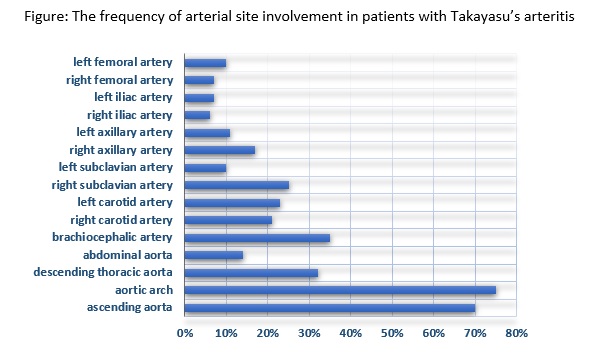Back
Poster Session C
Vasculitis
Session: (1543–1578) Vasculitis – Non-ANCA-Associated and Related Disorders Poster II
1550: Involvement of Iliofemoral Arteries in PET/CT Are Associated with Atherosclerotic Risk Factors in Takayasu's Arteritis
Sunday, November 13, 2022
1:00 PM – 3:00 PM Eastern Time
Location: Virtual Poster Hall

Haner Direskeneli, MD
Marmara University
ISTANBUL, Turkey
Abstract Poster Presenter(s)
SEMA KAYMAZ-TAHRA1, Salih Ozguven2, Nuh Filizoglu2, Ali Ugur Unal3, Fatma Alibaz-Oner4, Tunc Ones2, Tanju Yusuf Erdil2 and Haner Direskeneli5, 1Sancaktepe Prof Dr Ilhan Varank Training and Research Hospital, Rheumatology, Istanbul, Turkey, 2Marmara University School of Medicine, Department of Nuclear Medicine, Istanbul, Turkey, 3Marmara University School of Medicine, Rheumatology, Istanbul, Turkey, 4Marmara University, Rheumatology, Istanbul, Turkey, 5Marmara University, Rheumatology, Istanbul, Istanbul, Turkey
Background/Purpose: Iliofemoral artery disease, which is commonly observed in severe atherosclerosis, may also be present in Takayasu's arteritis (TAK). In this study we aimed to evaluate the characteristics of TAK patients with or without iliofemoral artery involvement in PET/CT.
Methods: Patients fulfilling ACR 1990 classification criteria for TAK and underwent PET-CT imaging were evaluated retrospectively. Demographic and clinical data were collected from patients' charts. Traditional cardiovascular risk factors: diabetes, hypertension, hyperlipidaemia, smoking history and body mass index (BMI) were recorded. PET Vascular Activity Score (PETVAS) was used to assess the quantitative PET activity.
Results: Seventy-one PET/CT scans of 52 (F/M: 42/10) patients with TAK were investigated. Mean age was 42.8±14.2 years and mean disease duration 5.6 ±5.3 years. The aortic arch (75%) was the most commonly involved artery. Iliofemoral arteries were involved in 9 (13%) patients. Patients with iliofemoral involvement were older (52.5±17.4 vs 39.9±12.4 years, p=0.036), had lower glucocorticoid (GC) dose (0 (0-7.5) vs 2.5 mg/day (0-80), p=0.049), higher CRP (36.1±28.1 vs 19.7±25.0 mg/L, p=0.041) and higher PETVAS (11.4±9.7 vs 4.2±3.9, p=0.018). Male gender (50% vs 14%, p=0.016) and current smokers (78% vs 35%, p=0.016) were also more present in the iliofemoral involvement group.
Conclusion: Involvement of iliofemoral arteries in PET/CT in TAK patients are associated with atherosclerotic risk factors more frequently. Therefore, anti-atherosclerotic approaches should be implemented more vigorously during the follow-up of TAK patients with lower extremity involvement.
.jpg) Table 1
Table 1
 Figure 1
Figure 1
Disclosures: S. KAYMAZ-TAHRA, None; S. Ozguven, None; N. Filizoglu, None; A. Unal, None; F. Alibaz-Oner, None; T. Ones, None; T. Erdil, None; H. Direskeneli, None.
Background/Purpose: Iliofemoral artery disease, which is commonly observed in severe atherosclerosis, may also be present in Takayasu's arteritis (TAK). In this study we aimed to evaluate the characteristics of TAK patients with or without iliofemoral artery involvement in PET/CT.
Methods: Patients fulfilling ACR 1990 classification criteria for TAK and underwent PET-CT imaging were evaluated retrospectively. Demographic and clinical data were collected from patients' charts. Traditional cardiovascular risk factors: diabetes, hypertension, hyperlipidaemia, smoking history and body mass index (BMI) were recorded. PET Vascular Activity Score (PETVAS) was used to assess the quantitative PET activity.
Results: Seventy-one PET/CT scans of 52 (F/M: 42/10) patients with TAK were investigated. Mean age was 42.8±14.2 years and mean disease duration 5.6 ±5.3 years. The aortic arch (75%) was the most commonly involved artery. Iliofemoral arteries were involved in 9 (13%) patients. Patients with iliofemoral involvement were older (52.5±17.4 vs 39.9±12.4 years, p=0.036), had lower glucocorticoid (GC) dose (0 (0-7.5) vs 2.5 mg/day (0-80), p=0.049), higher CRP (36.1±28.1 vs 19.7±25.0 mg/L, p=0.041) and higher PETVAS (11.4±9.7 vs 4.2±3.9, p=0.018). Male gender (50% vs 14%, p=0.016) and current smokers (78% vs 35%, p=0.016) were also more present in the iliofemoral involvement group.
Conclusion: Involvement of iliofemoral arteries in PET/CT in TAK patients are associated with atherosclerotic risk factors more frequently. Therefore, anti-atherosclerotic approaches should be implemented more vigorously during the follow-up of TAK patients with lower extremity involvement.
.jpg) Table 1
Table 1 Figure 1
Figure 1Disclosures: S. KAYMAZ-TAHRA, None; S. Ozguven, None; N. Filizoglu, None; A. Unal, None; F. Alibaz-Oner, None; T. Ones, None; T. Erdil, None; H. Direskeneli, None.

